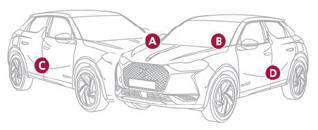DS 3: Driving recommendations / Towing
 Driving with a trailer
places greater
demands on the towing vehicle and
particular care must be taken.
Driving with a trailer
places greater
demands on the towing vehicle and
particular care must be taken.
 Do not exceed the maximum
towable
weights.
Do not exceed the maximum
towable
weights.
At altitude: reduce the maximum load by 10% per 1,000 metres of altitude; the lower air density at high altitudes decreases engine performance.
 New vehicle: do not
tow a trailer until the
vehicle has driven at least 620 miles
(1,000 kilometres).
New vehicle: do not
tow a trailer until the
vehicle has driven at least 620 miles
(1,000 kilometres).
 If the outside temperature
is high, let the
engine idle for 1 to 2 minutes after the
vehicle comes to a stop, to help it to cool.
If the outside temperature
is high, let the
engine idle for 1 to 2 minutes after the
vehicle comes to a stop, to help it to cool.
Before setting off
Nose weight
- Distribute the load in the trailer so that the heaviest items are as close as possible to the axle and the nose weight (at the point where it joins your vehicle) approaches the maximum permitted without exceeding it.
Tyres
- Check the tyre pressures of the towing vehicle and of the trailer, observing the recommended pressures.
Lighting
- Check the electrical signalling on the trailer and the headlamp beam height of your vehicle.
 If a genuine towing device
is used, the
rear parking sensors will be deactivated
automatically to avoid the audible signal.
If a genuine towing device
is used, the
rear parking sensors will be deactivated
automatically to avoid the audible signal.
When driving
Cooling
Towing a trailer uphill causes the coolant temperature to increase. The maximum towable load depends on the gradient and the exterior temperature. The fan’s cooling capacity does not increase with engine speed.
- Reduce speed and lower the engine speed to limit the amount of heating produced.
- Pay constant attention to the coolant temperature.
 If this warning lamp and the
STOP
warning lamp come on, stop the
vehicle and switch off the engine as soon as
possible.
If this warning lamp and the
STOP
warning lamp come on, stop the
vehicle and switch off the engine as soon as
possible.
Brakes
Using the engine brake is recommended to limit the overheating of the brakes. Braking distances are increased when towing a trailer.
Side wind
Bear in mind that the vehicle will be more susceptible to wind when towing.
 Noise (Electric)
Noise (Electric)
On the outside
Due to the vehicle’s quiet operation when driving,
the driver must pay particular attention.
At speeds of up to 19 mph (30 km/h), the
pedestrian horn warns other road users of the
vehicle’s presence...
 Anti-theft protection
Anti-theft protection
Electronic immobiliser
The keys include an electronic engine immobiliser
system, with a code that must be recognised in
order for starting to be possible...
Other information:
DS 3 2016-2026 Owners Manual: Steering mounted controls
Radio: Select the previous/next preset radio station. Select the previous/next item in a menu or a list. Media: Select the previous/next track. Select the previous/next item in a menu or a list. Radio: Short press: display the list of radio stations...
DS 3 2016-2026 Owners Manual: Deactivation/Activation. Malfunction
Deactivation/Activation Press this button to deactivate/reactivate the system at any time. Deactivation is signalled by the lighting of the indicator lamp in the button and this warning lamp in the instrument panel. The system is automatically reactivated every time the ignition is switched on...
Categories
- Manuals Home
- 1st Generation DS 3 Owners Manual
- 1st Generation DS 3 Service Manual
- Stop & Start
- Activation/Deactivation
- Door mirrors
- New on site
- Most important about car
Identification markings
Various visible markings for vehicle identification and vehicle search.

